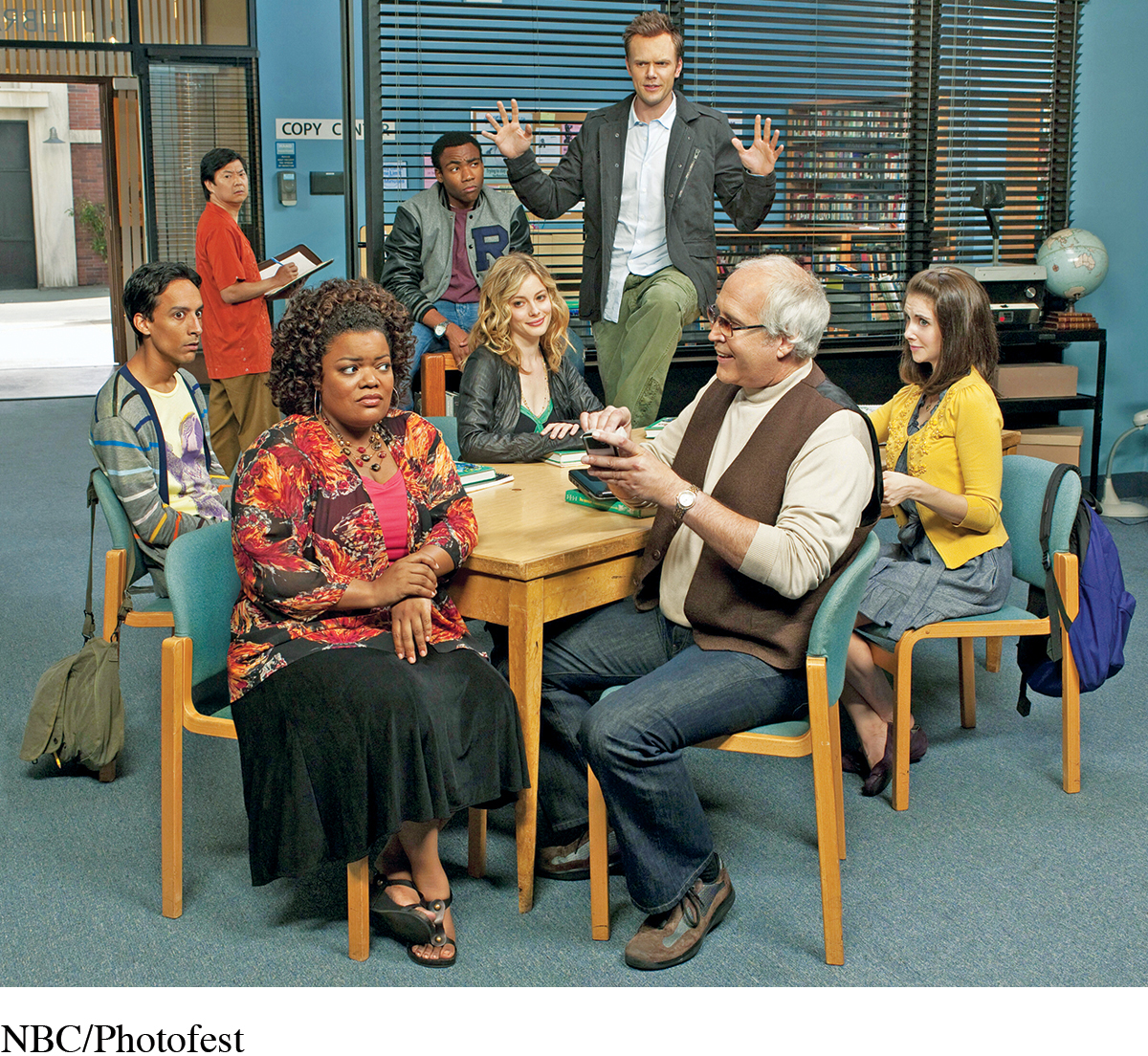The Nature of Friendship
Like family and romantic bonds, friendship plays a crucial role in our lives. Friendship is an important source of emotional security and self-esteem (Rawlins, 1992). Friendship facilitates a sense of belonging when we’re young, helps solidify our identity during adolescence, and provides satisfaction and social support when we’re elderly (Miller, Hefner, & Scott, 2007). But what exactly is friendship?
FRIENDSHIP DEFINED
Friendship is a voluntary interpersonal relationship characterized by intimacy and liking (McEwan, Babin Gallagher, & Farinelli, 2008). Whether it’s casual or close, short or long term, friendship has several distinguishing characteristics.
self-reflection
What constraints, if any, do you face in whom you can choose as friends? Who puts these limits on you? In your experience, do you have more, or less, freedom in choosing friends than lovers? How does this influence your choice of friends?
Friendship Is Voluntary We have greater liberty in choosing our friends than we do in choosing partners for any other relationship type (Sias et al., 2008). Whether a friendship forms is determined largely by the people involved, based on their mutual desire to create such a relationship. This is different from romantic, workplace, and family involvements. Consider romantic relationships. You may face substantial familial or cultural constraints in your choice of romantic partners. You may be expected (or allowed) to date only people of a certain age, gender, ethnicity, religion, or income level. You may even have a spouse chosen for you in an arranged marriage. In the workplace (discussed in our Appendix), you are required to work collaboratively with certain people, whether you like them or not. And in your family, you’re bound to others through birth, adoption, or the creation of a stepfamily. These ties are involuntary. As French poet Jacques Delille (1738–1813) put it, “Fate chooses your relations, you choose your friends.”
358

Friendship Is Driven by Shared Interests Similarity is the primary force that draws us to our friends (Parks & Floyd, 1996). This is true across ages, genders, sexual orientations, and ethnicities. One practical implication of this is that when your interests and activities change, so do your friendships. If you change your political or religious beliefs or suffer an injury that prevents you from playing a beloved sport, friendships related to those things may change as well. Some friendships will endure—the focus of the relationship shifting to new points of commonality—but others will fade away. One of the most common reasons for friendships ending is a change in shared interests and beliefs (Miller et al., 2007).
Friendship Is Characterized by Self-Disclosure We consider most people in our lives “acquaintances.” Only a select few rise to the level of “friends.” What distinguishes the two groups? Self-disclosure. Both men and women report that being able to freely and deeply disclose is the defining feature of friendship (Parks & Floyd, 1996). Self-disclosure between friends means sharing private thoughts and feelings, and believing that “we can tell each other anything.” The relationship between friendship and self-disclosure is reciprocal as well. The more you consider someone a friend, the more you will disclose; and the more you disclose, the more you will consider that person a friend (Shelton, Trail, West, & Bergsieker, 2010).
359
Friendship Is Rooted in Liking We feel affection and respect for our friends. In other words, we like them (Rubin, 1973). We also enjoy their company; pleasure in sharing time together is a defining feature of friendships (Hays, 1988). At the same time, because friendships are rooted in liking—rather than love—we’re not as emotionally attached to our friends as we are to other intimates, and we’re not as emotionally demanding of them. Correspondingly, we’re expected to be more loyal to and more willing to help romantic partners and family members than friends (Davis & Todd, 1985).
self-reflection
Call to mind your three closest friends in middle school. Then do the same for high school. Now think about your three closest friends today. Are the lists the same? How have they changed? Why? What does this tell you about the volatility of friendships?
Friendship Is Volatile Friendships are less stable, more likely to change, and easier to break off than family or romantic relationships (Johnson, Wittenberg, Villagran, Mazur, & Villagran, 2003). Why? Consider the differences in depth of commitment. We’re bonded to friends by choice, rooted in shared interests. But we’re bonded to families by social and legal commitment, and to lovers by deep emotional and sexual attachment. These loyalties mean we may choose or forgo professional opportunities to preserve romances or stay close to family. But most of us will choose to pursue our careers over staying geographically close to friends (Patterson, 2007).
FRIENDSHIP FUNCTIONS
Friendships serve many functions in our lives. Two of the most important are that they help us fulfill our need for companionship—chances to do fun things together and receive emotional support—and they help us achieve practical goals—deal with problems or everyday tasks (de Vries, 1996). These functions are not mutually exclusive, as many friendships facilitate both.
Communal Friendships One of the functions friendships serve is enabling us to share life events and activities with others. Compared to family and work relationships, friendship interactions are the least task oriented and tend to revolve around leisure activities, such as talking or eating (Argyle & Furnham, 1982). Scholar William Rawlins (1992) describes friendships that focus primarily on sharing time and activities together as communal friendships. Communal friends try to get together as often as possible, and they provide encouragement and emotional support to one another during times of need. Because emotional support is a central aspect of communal friendship, only when both friends fulfill the expectations of support for the relationship does the friendship endure (Burleson & Samter, 1994).
self-reflection
Do you have more communal or agentic friends? How do you communicate differently with the two types of friends? Which type of friend do you depend on more, day to day? Why?
Agentic Friendships We also look to friends for help in achieving practical goals in both our personal and our professional lives. Friends help us study for exams, fix cars, set up computers, and complete professional projects. Friendships in which the parties focus primarily on helping each other achieve practical goals are known as agentic friendships (Rawlins, 1992). Agentic friends value sharing time together—but only if they’re available and have no other priorities at the moment. They also aren’t interested in the emotional interdependence and mutual sharing of personal information that characterize communal friendships. They’re available when the need arises, but beyond that, they’re uncomfortable with more personal demands or responsibilities. For example, an agentic friend from work may gladly help you write up a monthly sales report, but she may feel uncomfortable if you ask her for advice about your romantic problems.
360

FRIENDSHIP ACROSS THE LIFE SPAN
The importance we attribute to our friendships changes throughout our lives. Up through fourth grade, most children look to their family as their sole source of emotional support (Furman & Simon, 1998). If a child suffers a disappointment at school, has a frightening dream, or just wants to share the events of the day, he or she will turn to parents or siblings. But during adolescence, children slowly transfer their emotional attachment from their family to friends (Welch & Houser, 2010). For example, by seventh grade, young people rely just as much on same-sex friends as they do on family for support. By tenth grade, same-sex friends have become the principal providers of emotional support. This trend continues into early adulthood: for college students, friends are the primary relationship for fulfilling relational needs (McEwan et al., 2008).
By middle adulthood, many people form long-term romantic commitments and start families of their own. Consequently, their romantic partners and children become the primary providers of companionship, affection, and support. The importance of friendships begins to wane (Carbery & Buhrmester, 1998). This is especially the case for married men, who before marriage tend to spend most of their time with male friends (Cohen, 1992). Late in life, however, the pattern shifts back once more, as spouses and siblings pass on and children form their own families. For the elderly, friendships are the most important relationships for providing social support and intimacy (Patterson, 2007).
FRIENDSHIP, CULTURE, AND GENDER
361
People from different cultures have varied expectations regarding friendships. For example, most Westerners believe that friendships don’t endure, that you’ll naturally lose some friends and gain others over time (Berscheid & Regan, 2005). This belief contrasts sharply with attitudes in other cultures, in which people view friendships as deeply intimate and lasting. As just one example, when asked to identify the closest relationship in their lives, Euro-Americans tend to select romantic partners, whereas Japanese tend to select friends (Gudykunst & Nishida, 1993).
Friendship beliefs and practices across cultures are also entangled with gender norms. In the United States and Canada, for instance, friendships between women are often stereotyped as communal, whereas men’s friendships are thought to be agentic. But male and female same-sex friendships are more similar than they are different (Winstead, Derlaga, & Rose, 1997).1 Men and women rate the importance of both kinds of friendships equally (Roy, Benenson, & Lilly, 2000), and studies of male friendships in North America have found that companionship is the primary need met by the relationship (Wellman, 1992).
At the same time, Euro-American men, unlike women, learn to avoid direct expressions of affection and intimacy in their friendships with other males. Owing to traditional masculine gender roles, a general reluctance to openly show emotion, and homophobia (among other factors), many men avoid verbal and nonverbal intimacy in their same-sex friendships, such as disclosing personal feelings and vulnerabilities, touching, and hugging (Bank & Hansford, 2000). But in many other cultures, both men and women look to same-sex friends as their primary source of intimacy. For example, in southern Spain, men and women report feeling more comfortable revealing their deepest thoughts to same-sex friends than to spouses (Brandes, 1987). Traditional Javanese (Indonesian) culture holds that marriage should not be too intimate and that a person’s most intimate relationship should be with his or her same-sex friends (Williams, 1992).
FRIENDSHIP AND TECHNOLOGY

self-reflection
Think of friends you only know and interact with online, and compare them with the friends who populate your offline world. Which friends do you consider closer? When you’re confronted with a challenging problem or personal crisis, which friends do you turn to for support? Why?
As with other interpersonal relationships, communication technologies such as social networking sites, Instagram, Snapchat, Twitter, smartphones, e-mail, and text-messaging have reshaped the way people create friendships. In the past, people forged friendships slowly. They took time to discover the values and interests of their neighbors, coworkers, and acquaintances, and only then built friendships with those who shared their values and interests. Now, however, you can form friendships quickly and with more people—some whom you may never actually meet in person—simply by friending them on Facebook or other online communities (Stafford, 2005). This provides a valuable resource to people suffering from chronic shyness. They can interact with others and garner social and emotional support without suffering the anxiety that direct face-to-face contact may cause (Pennington, 2009).
362
Of course, just because someone is your “Facebook friend” doesn’t necessarily mean that they’re a “real” friend. For example, 80 percent of Facebook users report that their real-world friends are also Facebook friends (Pennington, 2009). But the inverse isn’t true. Most people have dozens of friends, four (or so) close friends, and one (or more) “best” friend—yet well over three hundred Facebook friends (Pennington, 2009). The vast bulk of these “friends” aren’t friends at all but instead coworkers, acquaintances, neighbors, family, and the like.
Communication technologies make it possible for friends to stay constantly connected with one another. For better or worse, you can now keep your friends updated 24/7 on the latest news in your life through posts and messages. Interestingly, much like within families, technology does not replace in-person interaction. People who regularly use cell phones to call and text their friends are more likely to also seek face-to-face encounters (Wang & Andersen, 2007).
Despite all of this technology, people continue to recognize the superiority of offline relationships and communication. Studies comparing offline versus online friendships find that offline friendships have higher degrees of intimacy, understanding, interdependence, and commitment (Chan & Cheng, 2004). Additionally, people prefer face-to-face interactions with friends when discussing deeply personal or troubling topics (Pennington, 2009).